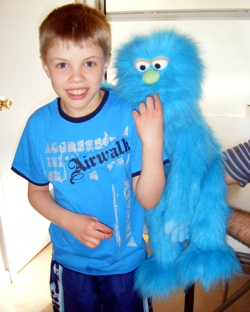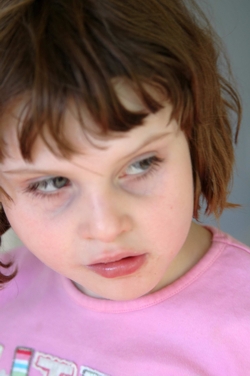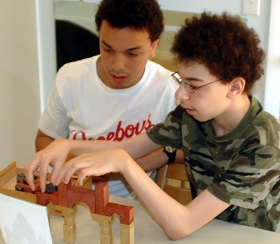Our Perspective on Autism
At a Glance
Autism and Autism Spectrum Disorder (ASD) are disorders of brain development characterized by difficulties in social interaction, communication and repetitive behaviors.
Current research suggests that there are multiple causes for autism. It is highly possible that there are multiple distinct types of autism, requiring different approaches to treatment.
Because there are significant differences among children with ASD, treatment needs also vary widely. We advocate assessing each child thoroughly to determine his or her individual strengths and difficulties and then planning treatment to fit the child’s unique needs.
Many children with ASD have additional neurological issues, such as motor planning or executive function difficulties, which often go unaddressed. The intelligence of these children is usually underestimated and they do not progress well with social and communication skills until their other neurological issues are addressed. The Growing Minds team has extensive experience in assessment and targeted program methods for these issues.
Practice changes the nervous system and allows ongoing development. All children, even those whose difficulties are most severe, can continue to improve as long as they are helped to practice.
We assess children for strengths and weaknesses both within and outside the common parameters of autism. Then we set progressive targets or goals that will help the child develop greater competence in the necessary areas. We create a loving, accepting and encouraging teaching environment, using methods that have been shown to be effective (evidence-based), in programs tailored to the child’s specific needs.
Every child with autism can grow, develop and enjoy a greater quality of life.
What is Autism Spectrum Disorder?
 Autism spectrum disorder (ASD) and autism are general terms for a group of complex disorders of brain development. They include Autistic Disorder, Rett Syndrome, Pervasive Developmental Disorder, Not Otherwise Specified (PDD-NOS) and Asperger Syndrome.
Autism spectrum disorder (ASD) and autism are general terms for a group of complex disorders of brain development. They include Autistic Disorder, Rett Syndrome, Pervasive Developmental Disorder, Not Otherwise Specified (PDD-NOS) and Asperger Syndrome.
These conditions are characterized by varying degrees of difficulty in social interaction, verbal and non-verbal communication and repetitive behaviors. Individuals with ASD may also have difficulties in intellectual performance, motor coordination and attention, as well as with health issues such as sleep and gastrointestinal disturbances. Some people with autism excel in visual skills, music, math and art.
According to the U.S. Centers for Disease Control and Prevention, around 1 in 88 American children are on the autism spectrum – a 700 percent increase in prevalence over the past two decades. Careful research shows that this increase is only partly explained by improved diagnosis and awareness. Studies also show that autism is much more common among boys than girls. An estimated 1 out of 54 boys is diagnosed with ASD in the United States.
What Causes Autism?
Until recently, science offered no explanations for the causes of ASD. Research is finally yielding more information. Over the last few years, scientists have identified a number of rare gene changes, or mutations, associated with autism. A small number of these alone are sufficient to cause autism. Most cases of autism, however, appear to be caused by a combination of autism risk genes and environmental stressors influencing early brain development.
To date, researchers have operated from the assumption that autism is one distinct condition. But each time a cause for autism is discovered, it soon becomes clear that this cause is only true for a percentage of diagnosed individuals. This has led many practitioners to suspect that that there may be many distinct forms of autism that do not share common causes. This theory is consistent with the experience of the Growing Minds team in working with hundreds of children and teens with ASD.
 Our Perspective on Autism
Our Perspective on Autism
If there is no single type of autism, the diagnosis of ASD does not tell us much about a child. Because there are significant differences among children with ASD, children’s treatment needs may also vary widely. Rather than assume that a child has a particular difficulty that is commonly associated with autism, the Growing Minds Program begins with the assumption that each child must be assessed to determine his or her specific difficulties. For instance, while many children with ASD are predominantly visual learners, some are not.
Contrary to popular belief, some children with ASD are affectionate and outgoing. Some children on the spectrum like to be touched. Others have good eye contact. Some pretend, some are capable of deception and some show good signs of “theory of mind” (the ability to understand that others have beliefs, desires and intentions different from one’s own).
Because individual differences are so prevalent among people with ASD, we believe that effective treatment requires individual assessment, leading to programs that are custom-designed for the specific strengths and weaknesses of each child.
There are additional neurological issues that are not clinically associated with autism, while remaining highly impactful for those children who are affected by them. These issues are usually ignored in diagnosis and treatment planning. Some researchers suggest that at least one-third of children on the autism spectrum have difficulties with executive function (a set of skills that enable goal-directed behavior, which can be affected by neurological impairments). But because these difficulties only affect one-third of those with ASD, they are not considered defining characteristics of autism and are seldom discussed or addressed in treatment.
Many children on the autism spectrum (but not all) have dyspraxia (movement difficulties which can affect gross motor, fine motor, speech motor or all motor functions). Again, because this type of difficulty does not affect all children on the spectrum, it is often ignored. Many programs for ASD children are designed only to deal with issues thought to be common among most children with autism, such as social and communication issues. However, there are many children on the spectrum who cannot progress well with social and communication issues without also addressing their difficulties with executive function and/or motor planning. Individuals with these difficulties make the best progress when teaching methods are designed to accommodate their specific needs. The Growing Minds team has extensive experience in assessment and targeted program design for children with these issues.
A Strength-Based Approach
 Most programs do not prioritize finding the specific strengths of the child and helping the child use his or her strengths to overcome difficulties. Most assessments and programs focus primarily on deficits. We are adept at helping children to find and more fully develop their strengths.
Most programs do not prioritize finding the specific strengths of the child and helping the child use his or her strengths to overcome difficulties. Most assessments and programs focus primarily on deficits. We are adept at helping children to find and more fully develop their strengths.
Every child with autism can improve. If strong, evidence- based methods are used, in an atmosphere that is infused with love, acceptance and encouragement, children can be helped to practice the very things that they find most difficult. There is more and more evidence showing that the nervous system can change depending on the demands placed on it. This is called “activity dependent plasticity.” This principle has been shown to hold true, not only for verbal and intellectual development, but for the brain structures that affect movement, spatial intelligence, etc. This means that all children, even those whose difficulties are most severe, can continue to grow, develop and improve as long as they are helped to practice.
Autism is not a defining quality of a person, nor is it an enemy. Each child has a unique personality, strengths, skills, gifts and deficits. We are not trying to make children be “neuro-typical.” We want to help each child develop enough motor skill so that he can move freely. We want to help each child develop an ability to communicate, should she choose to do so. We want to help each child develop enough social skill so that he can feel comfortable with others and develop relationships if he wishes to do so.
We want to help children develop the cognitive skills that will enable them to participate in the world of facts, information and ideas should they choose to do so – as receivers, contributors or both, according to their wishes. We want to help children develop the skills that they need to live independently, should they wish to do so. We want to help children develop the tools that they can use to enable themselves to be happy and to feel emotions that they find enjoyable and fulfilling. More competence means more choices and more options. More options mean greater freedom. We love and respect diversity, even as we teach competence and enable access to greater opportunities in life.
Summary
Our program assesses children for strengths and weaknesses both within and outside of the common parameters of autism. From this assessment, we set progressive targets or goals that will help the child develop greater competence in the necessary skill areas. We use methods that have been shown to be effective (evidence-based) to help each child improve, in programs tailored to his or her specific needs. We believe that each child can be helped to improve with effective teaching and sufficient practice.